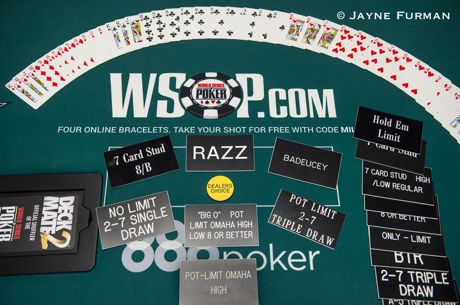Book Excerpt: 'Mastering Mixed Games' by Dylan Linde

Countless strategy tomes exist for the ever-present game of no-limit hold'em, offering players everything from a sound base of fundamentals to breakdowns of more advanced ideas like range construction and blocker usage.
However, the mixed games have been far less explored and far less explained, and that's where Dylan Linde's new book "Mastering the Mixed Games" comes in. Linde and D&B Publishing are targeting those looking to branch out from no-limit hold'em and round out their poker games.
A slew of limit games are covered: Omaha hi-lo, razz, stud, stud hi-lo and 2-7 triple draw. Linde goes through each game one-by-one, starting with explanations of the rules and how to play. More advanced players can skip these parts and get to the meat of the book, where Linde promises to teach concepts including:
- Starting hand selection
- Game-specific applications of general concepts
- How to recognize and exploit the mistakes and tendencies of other players
Scheduled for a June 2019 release in the U.S., "Mastering Mixed Games" will open up many more doors to potential profit for poker players stuck in a no-limit hold'em rut.
| Title: | MASTERING MIXED GAMES |
| Author: | Dylan Linde |
| Publisher: | D&B Poker |
| Price: | $34.95 (paperback), $24.95 (eBook) |
| Pages: | 304 |
| Publication Date: | June 2019 (July 2019 in Europe) |
You can pre-order a copy of the ebook or physical book from D&B’s website.
Extract from Chapter on Razz
Third Street
Play on third street is all a question of context and math. Firstly, the bring‑in will generally be unplayable, which means that you can attack with a little more impunity. You will always be getting an excellent price to attempt a steal. The key to figuring out when to steal is by paying attention to the up‑cards. It is also worth noting that, early on in Razz, hands run extremely close in equity. Here are some examples of strong hands against other strong hands on third street:
| Hand | Equity |
|---|---|
| (2x7x)-3x | 44.70% |
| (Ax2x)-3x | 55.30% |
| Hand | Equity |
|---|---|
| (2x7x)-3x | 45.50% |
| (Ax4x)-2x | 54.50% |
| Hand | Equity |
|---|---|
| (2x7x)‑3x | 46.98% |
| (Ax4x)‑5x | 53.02% |
| Hand | Equity |
|---|---|
| (2x7x)‑3x | 46.98% |
| (Ax4x)‑5x | 53.02% |
This means that, as in Stud, you are going to want to push other players out where you can, and obtain an overlay on the pot because of the dead money. However, unlike Stud, you can never actually be that far behind. If you have (2x3x)‑7x and they have (Ax2x)‑3x you are still close to flipping; there is no Razz equivalent of rolled‑up.
This leads to the key strategy of how to play third street. You want to get it heads‑up whenever you can but, when you cannot, there is no real reason to re‑raise and bloat the pot. You are never gaining much equity. Furthermore, when you put additional small bets in on third street when equities are close, you make it more difficult to price people out or get them to make mistakes later in the hand due to the already bloated nature of the pot. So, anytime that there are already two or more players in the pot, you should flat‑call the bets. Here are some three-way equities:
| Hand | Equity |
|---|---|
| (2x3x)‑Ax | 45.50% |
| (7x6x)‑2x | 29.39% |
| (3x8x)‑4x | 25.11% |
| Hand | Equity |
|---|---|
| (2x3x)‑Ax7x | 57.84% |
| (7x6x)‑2x3x | 35.36% |
| (3x8x)‑4x9x | 6.80% |
With (2x3x)‑Ax, you are ahead of the other two holdings on third street, but the equity jump on fourth is huge and no‑one is ever folding fourth.
Conversely, when they hit and you miss:
| Hand | Equity |
|---|---|
| (2x3x)‑AxKx | 25.22% |
| (7x6x)‑2x3x | 59.24% |
| (3x8x)‑4x9x | 15.54% |
You lose a huge amount of equity.
This demonstrates the importance of attempting to isolate whenever possible. If you can get an opponent to fold a hand that may have 17% equity three‑ways by making it two bets to call before they act, you have engineered a huge coup. The other benefit of an aggressive approach to isolating and attempting to get pots heads‑up is that, because equities run so close, you cannot get punished too much for isolating with a hand slightly worse than your opponent’s.
There is no real starting hand chart for Razz because opening ranges are based up the up‑cards. As with Stud High, you construct your opening range based on the cards that are up and can narrow your opponents’ ranges using the up‑cards the opponent is opening into to determine the strength of their down‑cards. There are times that you might have the best up-card with a jack or 10 and there are times where you will have 7-6-4 and it will be totally unplayable. That being said, the following are general guidelines for third street hand selection.
You will want to play any hand that has the table board‑locked. For example, you have a 7 up and 2-3 in the hole and your opponents have 8, 8, 9, K, 10 showing. However, note that in some spots, specifically steal spots where you have an 8 or a 9 or a 10, having your opponents board-locked on third street doesn’t mean much if your hand is actually trash. You will always be ahead but as illustrated below you don’t have a hammerlock on the hand.
| Hand | Equity |
|---|---|
| (Ax3x)‑Jx | 44.26% |
| (6x7x)‑10x | 55.74% |
| Hand | Equity |
|---|---|
| (Ax3x)‑10x | 45.84% |
| (6x8x)‑9x | 54.16% |
| Hand | Equity |
|---|---|
| (Ax3x)-Qx | 38.41% |
| (6x8x)-9x | 61.59% |
Another thing to note about these equities is that they are hot/cold. However, what is actually going to happen is when the (Ax3x)‑Qx holding continues past fifth street they are going to have a smooth draw, while a hand such as (6x8x)‑9x is really hamstrung and cannot make anything big. So, any big pot you play, and most of the hands that go to showdown, will heavily favor the (Ax3x)‑Qx hand when showdown is reached. The greatest impediment towards bring‑in defense ranges is that they will often have to fold on fourth or fifth street as their board bricks out.
| Hand | Equity |
|---|---|
| (Ax3x)‑Jx6x2x | 56.78% |
| (6x7x)‑10x4x3x | 43.22% |
This hand illustrates that, although you have hit better than the (Ax3x)‑Jx, you are now behind and you are about to play the big bet streets.
The second group of hands that you should play are hands with a good, but not the best, up‑card with good down‑cards. In other words, because, as we have illustrated, the equities run so close together, you do not need to be certain that you have the actual best hand. Therefore, any hand with two wheel cards in the hole and an 8 or lower up‑card are playable.
You want to be drawing smooth and you want to keep the dead cards in mind. That is because you really want your pair cards to be dead and your outs to be live as this can give you almost double outs. Here you can see the considerable difference in equities between having dead pairing cards and not.
Dead cards: 5, 5, 5
| Hand | Equity |
|---|---|
| (3x4x)‑7x | 28.68% |
| (2x3x)‑6x | 26.08% |
| (Ax4x)‑5x | 45.24% |
No dead cards
| Hand | Equity |
|---|---|
| (3x4x)‑7x | 33.24% |
| (2x3x)‑6x | 32.62% |
| (Ax4x)‑5x | 34.14% |
Defending against steals is important in Razz as many pots will be folded to the lowest card remaining who may automatically raise with more or less any two down‑cards. Such a scenario occurs when there is a 3 up with only a queen behind and you are the bring‑in with the K. Here is an example of equity in a steal scenario:
| Hand | Equity |
|---|---|
| (5x4x)‑Kx | 42.80% |
| (XxXx)‑3x | 57.21% |
You can see in this example that having two wheel cards in the hole is going to have a lot of equity against a player stealing with any two down‑cards and a 3 up. Noticing who has a tendency to steal is important for range construction. If your opponents are extremely straightforward and do not steal often, then you do not have to be as prone to defend. Your price from the bring‑in makes the above scenario a slam dunk defend.
Sponsored content provided by D&B Publishing.









